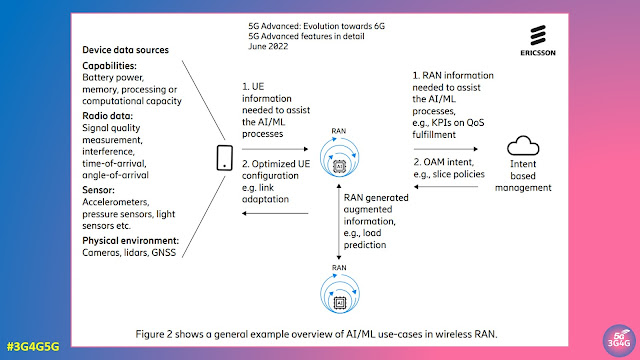Artificial Intelligence (AI) and Machine Learning (ML) has been touted to automate the network and simplify the identification and debug of issues that will arise with increasing network complexity. For this reason 3GPP has many different features that are already present in Release-17 but are expected to evolve further in Release-18.
I have already covered some of this topics in earlier posts. Ericsson's recent whitepaper '5G Advanced: Evolution towards 6G' also has a good summary on this topic. Here is an extract from that:
Intelligent network automation
With increasing complexity in network design, for example, many different deployment and usage options, conventional approaches will not be able to provide swift solutions in many cases. It is well understood that manually reconfiguring cellular communications systems could be inefficient and costly.
Artificial intelligence (AI) and machine learning (ML) have the capability to solve complex and unstructured network problems by using a large amount of data collected from wireless networks. Thus, there has been a lot of attention lately on utilizing AI/ML-based solutions to improve network performance and hence providing avenues for inserting intelligence in network operations.
AI model design, optimization, and life-cycle management rely heavily on data. A wireless network can collect a large amount of data as part of its normal operations. This provides a good base for designing intelligent network solutions. 5G Advanced addresses how to optimize the standardized interfaces for data collection while leaving the automation functionality, for example, training and inference up to the proprietary implementation to support full flexibility in the automation of the network.
AI/ML for RAN enhancements
Three use cases have been identified in the Release 17 study item related to RAN performance enhancement by using AI/ML techniques. Selected use cases from the Release 17 technical report will be taken into the normative phase in the next releases. The selected use cases are: 1) network energy saving; 2) load balancing; and 3) mobility optimization.
The selected use cases can be supported by enhancements to current NR interfaces, targeting performance improvements using AI/ML functionality in the RAN while maintaining the 5G NR architecture. One of the goals is to ensure vendor incentives in terms of innovation and competitiveness by keeping the AI model implementation specific. As shown in Fig.2 (on the top) an intent-based management approach can be adopted for use cases involving RAN-OAM interactions. The intent will be received by the RAN. The RAN will need to understand the intent and trigger certain functionalities as a result.
Ericsson White Paper - 5G Advanced: Evolution towards 6G - https://t.co/9ZKnC8PDxX#Free5Gtraining #Ericsson #5G #B5G #5GAdvanced #6G #5GNR #5GC #Timeline #XR #RedCap #NetworkAutomation #EnergySavings #DeterministicNetworking #IoT pic.twitter.com/eeI4SKvIRC
— Free 5G Training (@5Gtraining) July 21, 2022
AI/ML for physical layer enhancements
It is generally expected that AI/ML functionality can be used to improve the radio performance and/or reduced the complexity/overhead of the radio interface. 3GPP TSG RAN has selected three use cases to study the potential air interface performance improvements through AI/ML techniques, such as beam management, channel state information feedback enhancement, and positioning accuracy enhancements for different scenarios. The AI/ML-based methods may provide benefits compared to traditional methods in the radio interface. The challenge will be to define a unified AI/ML framework for the air interface by adequate AI/ML model characterization using various levels of collaboration between gNB and UE.
AI/ML in 5G core
5G Advanced will provide further enhancements of the architecture for analytics and on ML model life-cycle management, for example, to improve correctness of the models. The advancements in the architecture for analytics and data collection serve as a good foundation for AI/ML-based use cases within the different network functions (NFs). Additional use cases will be studied where NFs make use of analytics with the target to support in their decision making, for example, network data analytics functions (NWDAF)- assisted generation of UE policy for network slicing.
Related Posts:
- The 3G4G Blog: What Is the Role of AI and ML in the Open RAN and 5G Future?
- The 3G4G Blog: 3GPP Release-18 Work Moves Into Focus as Release-17 Reaches Maturity
- The 3G4G Blog: NWDAF in 3GPP Release-16 and Release-17
- The 3G4G Blog: 5G-Advanced Flagship Features
- The 3G4G Blog: 3GPP's 5G-Advanced Technology Evolution from a Network Perspective Whitepaper
- Free 6G Training: Qualcomm Pushing the boundaries of AI research




